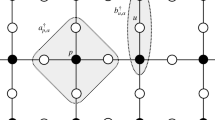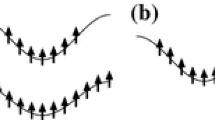Abstract
Whether spin-independent Coulomb interaction in an electron system can be the origin of ferromagnetism has been an open problem for a long time. Recently, a “constructive” approach to this problem has been developed, and the existence of ferromagnetism in the ground states of certain Hubbard models was established rigorously. A special feature of these Hubbard models is that their lowest bands (in the corresponding single-electron problems) are completely flat. Here we study models obtained by adding small but arbitrary translation-invariant perturbation to the hopping Hamiltonian of these flat-band models. The resulting models have nearly flat lowest bands. We prove that the ferromagnetic state is stable against a single-spin flip provided that Coulomb interactionU is sufficiently large. (It is easily found that the same state is unstable against a single-spin flip ifU is small enough.) We also prove upper and lower bounds for the dispersion relation of the lowest energy eigenstate with a single flipped spin, which bounds establish that the model has “healthy” spin-wave excitation. It is notable that the (local) stability of ferromagnetism is proved in nonsingular Hubbard models, in which we must overcome competition between the kinetic energy and the Coulomb interaction. We also note that this is one of the very few rigorous and robust results which deal with truly non-perturbative phenomena in many-electron systems. The local stability strongly suggests that the Hubbard models with nearly flat bands have ferromagnetic ground states. We believe that the present models can be studied as paradigm models for (insulating) ferromagnetism in itinerant electron systems.
Similar content being viewed by others
References
P. W. Anderson, inMagnetism I, G. T. Rado and H. Schul, eds. (Academic Press, New York, 1963).
P. W. Anderson,Phys. Rev. Lett. 21:13 (1968).
N. W. Ashcroft and N. D. Mermin,Solid State Physics (Saunders College, 1976).
G. Benffatto, G. Gallavotti, A. Procacci, and B. Scoppola,Commun. Math. Phys. 160: 93 (1994).
F. Bloch,Z. Phys. 57:545 (1929).
U. Brandt and A. Giesekus,Phys. Rev. Lett. 68:2648 (1992).
J. de Boer and A. Schadschneider,Phys. Rev. Lett. 75:4298 (1995).
B. Douçot and X. G. Wen,Phys. Rev. B 40:2719 (1989).
F. Dyson, E. H. Lieb, and B. Simon,J. Stat. Phys. 18:335 (1978).
J. Feldman, J. Magnen, V. Rivasseau, and E. Trubowitz, inThe LXII les Houches Summer School “Fluctuating Geometries in Statistical Mechanics and in Field Theory,” August 2–September 9 1994 [cond-mat/9503047].
D. Ghosh,Phys. Rev. Lett. 27:1584 (1971).
M. C. Gutzwiller,Phys. Rev. Lett. 10:159 (1963).
T. Hanisch and E. Müller-Hartmann,Ann. Physik,2:381 (1993).
W. J. Heisenberg,Z. Phys. 49:619 (1928).
C. Herring, inMagnetism IIB, G. T. Rado and H. Suhl, eds. (Academic Press, New York, 1966).
C. Herring, inMagnetism IV, G. T. Rado and H. Suhl, eds. (Academic Press, New York, 1966).
J. Hubbard,Proc. Roy. Soc. Lond A 276:238 (1963).
J. Kanamori,Prog. Theor. Phys. 30:275 (1963).
T. Kato,A Short Introduction to Perturbation Theory for Linear Operators (Springer-Verlag, Berlin, 1982).
W. Kohn,Phys. Rev. B 7:4388 (1973).
T. Koma and H. Tasaki,Phys. Rev. Lett. 68:3248 (1992).
K. Kusakabe, Ferromagnetism in strongly correlated electron systems, Ph.D. thesis, University of Tokyo (1993).
K. Kusakabe and H. Aoki,Phys. Rev. Lett. 72:144 (1994).
K. Kusakabe and H. Aoki,Physica B 194–196:215 (1994).
S. Liang and H. Pang, Preprint (1994) [cond-mat/9404003].
E. H. Lieb, inPhase Transitions (Wiley, Interscience,. 1971), p. 45.
E. H. Lieb,Phys. Rev. Lett. 62:1201 (1989).
E. H. Lieb and D. Mattis,Phys. Rev. 125:164 (1962).
D. C. Mattis,The Theory of Magnestism I (Springer-Verlag, Berlin, 1981).
A. Mielke,J. Phys. A 24:L73 (1991).
A. Mielke,J. Phys. A 24:3311 (1991).
A. Mielke,J. Phys. A 25:4335 (1992).
A. Mielke,Phys. Lett. A 174:443 (1993).
A. Mielke and H. Tasaki,Commun. Math. Phys. 158:341 (1993).
E. Müller-Hartmann,J. Low Temp. Phys. 99:349 (1995).
Y. Nagaoka,Phys. Rev. 147:392 (1966).
W. O. Putikka, M. U. Luchini, and M. Ogata,Phys. Rev. Lett. 69:2288 (1992).
M. Reed and B. Simon,Methods of Modern Mathematical Physics, Vol. IV (Academic Press, New York, 1978).
B. S. Shastry, H. R. Krishnamurthy, and P. W. Anderson,Phys. Rev. B 41:2375 (1990).
S. Q. Shen, Z. M. Qiu, and G. S. Tian,Phys. Rev. Lett. 72:1280 (1994).
J. C. Slater, H. Statz and G. F. Koster,Phys. Rev. 91:1323 (1953).
R. Strack and D. Vollhardt,Phys. Rev. Lett. 72:3425 (1994).
R. Strack and D. Vollhardt,J. Low Temp. Phys. 99:385 (1995).
A. Sütő,Phys. Rev. B 43:8779 (1991).
A. Sütő,Commun. Math. Phys. 140:43 (1991).
H. Tasaki,Phys. Rev. B. 40:9192 (1989).
H. Tasaki,Phys. Rev. Lett. 69:1608 (1992).
H. Tasaki,Phys. Rev. Lett. 70:3303 (1993).
H. Tasaki,Phys. Rev. Lett. 73:1158 (1994).
H. Tasaki,Phys. Rev. B 49:7763 (1994).
H. Tasaki,Phys. Rev. Lett. 75:4678 (1995).
H. Tasaki, in preparation.
D. J. Thouless,Proc. Phys. Soc. Lond. 86:893 (1965).
B. Tóth,Lett. Math. Phys. 22:321 (1991).
Author information
Authors and Affiliations
Rights and permissions
About this article
Cite this article
Tasaki, H. Stability of ferromagnetism in Hubbard models with nearly flat bands. J Stat Phys 84, 535–653 (1996). https://doi.org/10.1007/BF02179652
Received:
Accepted:
Issue Date:
DOI: https://doi.org/10.1007/BF02179652




